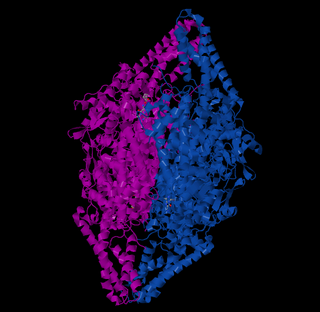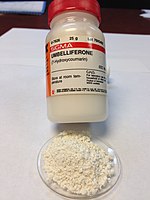
Cinnamic acid is an organic compound with the formula C6H5-CH=CH-COOH. It is a white crystalline compound that is slightly soluble in water, and freely soluble in many organic solvents. Classified as an unsaturated carboxylic acid, it occurs naturally in a number of plants. It exists as both a cis and a trans isomer, although the latter is more common.

Coumarin or 2H-chromen-2-one is an aromatic organic chemical compound with formula C9H6O2. Its molecule can be described as a benzene molecule with two adjacent hydrogen atoms replaced by an unsaturated lactone ring −(CH)=(CH)−(C=O)−O−, forming a second six-membered heterocycle that shares two carbons with the benzene ring. It belongs to the benzopyrone chemical class and considered as a lactone.

Gmelina arborea,, locally known as gamhar, is a fast-growing deciduous tree in the family Lamiaceae.

Methoxsalen, sold under the brand name Oxsoralen among others, is a medication used to treat psoriasis, eczema, vitiligo, and some cutaneous lymphomas in conjunction with exposing the skin to ultraviolet (UVA) light from lamps or sunlight. Methoxsalen modifies the way skin cells receive the UVA radiation, allegedly clearing up the disease. Levels of individual patient PUVA exposure were originally determined using the Fitzpatrick scale. The scale was developed after patients demonstrated symptoms of phototoxicity after oral ingestion of methoxsalen followed by PUVA therapy. Chemically, methoxsalen belongs to a class of organic natural molecules known as furanocoumarins. They consist of coumarin annulated with furan. It can also be injected and used topically.

Chlorogenic acid (CGA) is the ester of caffeic acid and (−)-quinic acid, functioning as an intermediate in lignin biosynthesis. The term "chlorogenic acids" refers to a related polyphenol family of esters, including hydroxycinnamic acids with quinic acid.

p-Coumaric acid is an organic compound with the formula HOC6H4CH=CHCO2H. It is one of the three isomers of hydroxycinnamic acid. It is a white solid that is only slightly soluble in water but very soluble in ethanol and diethyl ether.

The phenylpropanoids are a diverse family of organic compounds that are biosynthesized by plants from the amino acids phenylalanine and tyrosine in the shikimic acid pathway. Their name is derived from the six-carbon, aromatic phenyl group and the three-carbon propene tail of coumaric acid, which is the central intermediate in phenylpropanoid biosynthesis. From 4-coumaroyl-CoA emanates the biosynthesis of myriad natural products including lignols, flavonoids, isoflavonoids, coumarins, aurones, stilbenes, catechin, and phenylpropanoids. The coumaroyl component is produced from cinnamic acid.

Daidzein is a naturally occurring compound found exclusively in soybeans and other legumes and structurally belongs to a class of compounds known as isoflavones. Daidzein and other isoflavones are produced in plants through the phenylpropanoid pathway of secondary metabolism and are used as signal carriers, and defense responses to pathogenic attacks. In humans, recent research has shown the viability of using daidzein in medicine for menopausal relief, osteoporosis, blood cholesterol, and lowering the risk of some hormone-related cancers, and heart disease. Despite the known health benefits, the use of both puerarin and daidzein is limited by their poor bioavailability and low water solubility.
In enzymology, a trans-cinnamate 2-monooxygenase (EC 1.14.13.14) is an enzyme that catalyzes the chemical reaction
In enzymology, a trans-cinnamate 4-monooxygenase (EC 1.14.14.91) is an enzyme that catalyzes the chemical reaction

The enzyme phenylalanine ammonia lyase (EC 4.3.1.24) catalyzes the conversion of L-phenylalanine to ammonia and trans-cinnamic acid.:
In enzymology, a 2-coumarate O-beta-glucosyltransferase is an enzyme that catalyzes the chemical reaction

Dianthera pectoralis is an herb in the family Acanthaceae. This water-willow is widely known as tilo in Latin America and in Cuba. In Haiti, it is called chapantye and zeb chapantyè on Dominica and Martinique. Other folk names are freshcut, chambácarpintero ("carpenter"), té criollo, curia, death-angel, masha-hari, or "piri piri". This species was described by Nikolaus Joseph von Jacquin in 1760, who provided additional data in 1763. A well-marked variety, var. stenophylla, was described by Emery Clarence Leonard in 1958.

Indirect DNA damage occurs when a UV-photon is absorbed in the human skin by a chromophore that does not have the ability to convert the energy into harmless heat very quickly. Molecules that do not have this ability have a long-lived excited state. This long lifetime leads to a high probability for reactions with other molecules—so-called bimolecular reactions. Melanin and DNA have extremely short excited state lifetimes in the range of a few femtoseconds (10−15s). The excited state lifetime of compounds used in sunscreens such as menthyl anthranilate, avobenzone or padimate O is 1,000 to 1,000,000 times longer than that of melanin, and therefore they may cause damage to living cells that come in contact with them.

Aesculetin is a derivative of coumarin. It is a natural lactone that derives from the intramolecular cyclization of a cinnamic acid derivative.
Coumaroyl-coenzyme A is the thioester of coenzyme-A and coumaric acid. Coumaroyl-coenzyme A is a central intermediate in the biosynthesis of myriad natural products found in plants. These products include lignols, flavonoids, isoflavonoids, coumarins, aurones, stilbenes, catechin, and other phenylpropanoids.

Angelicin is the parent compound in a family of naturally occurring organic compounds known as the angular furanocoumarins. Structurally, it can be considered as benzapyra-2-one fused with a furan moiety in the 7,8-position. Angelicin is commonly found in certain Apiaceae and Fabaceae plant species such as Bituminaria bituminosa. It has a skin permeability coefficient (LogKp) of -2.46. The maximum absorption is observed at 300 nm. The 1HNMR spectrum is available; the infrared and mass spectra of angelicin can be found in this database. The sublimation of angelicin occurs at 120 °C and the pressure of 0.13 Pa. Angelicin is a coumarin.
The biosynthesis of phenylpropanoids involves a number of enzymes.

o-Coumaric acid is a hydroxycinnamic acid, an organic compound that is a hydroxy derivative of cinnamic acid. There are three isomers of coumaric acids — o-coumaric acid, m-coumaric acid, and p-coumaric acid — that differ by the position of the hydroxy substitution of the phenyl group.

Umbellic acid is a hydroxycinnamic acid. It is an isomer of caffeic acid.


























